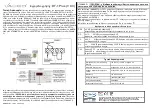UM10503
All information provided in this document is subject to legal disclaimers.
© NXP B.V. 2012. All rights reserved.
User manual
Rev. 1.3 — 6 July 2012
750 of 1269
NXP Semiconductors
UM10503
Chapter 26: LPC43xx Ethernet
26.7.5.2.10
Error response to DMA
For any data transfer initiated by a DMA channel, if the slave replies with an error
response, that DMA stops all operations and updates the error bits and the Fatal Bus
Error bit in the DMA Status register (
). That DMA controller can resume
operation only after soft resetting or hard resetting the core and re-initializing the DMA.
This DMA behavior is true for non-AHB interfaced DMAs that receive an error response.
26.7.5.3 Ethernet descriptors
The descriptor structure supports up to 8 DWORDS (32 bytes) and the IEEE 1588-2008
Advanced Timestamp feature. The features of the descriptor structure are:
•
Descriptor size can be 4 DWORDS (16 bytes) or 8 DWORDS (32 bytes) depending
on the setting of the ATDS bit in the DMA Bus Mode register (
•
Support buffers of up to 8 KB (useful for Jumbo frames).
•
The transmit descriptor stores the timestamp in TDES6 and TDES7 when you select
the Advanced Timestamp.
•
This receive descriptor structure is also used for storing the extended status (RDES4)
and timestamp (RDES6 and RDES7) when advanced timestamp feature or IPC full
offload is selected.
•
When the descriptor mode is selected, and the Timestamp feature is enabled, the
software needs to allocate 32-bytes (8 DWORDS) of memory for every descriptor.
When Timestamping or Receive IPC FullOffload engine are not enabled, the
extended descriptors are not required and the SW can use alternate descriptors with
the default size of 16 bytes. The core also needs to be configured for this change
using the bit 7 (ATDS: Alternate Descriptor Size) of DMA Bus Mode register
(
•
When a descriptor is chosen without Timestamp or Full IPC Offload feature, the
descriptor size is always 4 DWORDs (DES0-DES3).
26.7.5.3.1
Transmit descriptor
The transmit descriptor structure is shown in
. The application software must
program the control bits TDES0[31:20] during descriptor initialization. When the DMA
updates the descriptor, it write backs all the control bits except the OWN bit (which it
clears) and updates the status bits[19:0]. The contents of the transmitter descriptor word 0
(TDES0) through word 3 (TDES3) are given in
through
, respectively.
With the advance timestamp support, the snapshot of the timestamp to be taken can be
enabled for a given frame by setting bit TTSE: Transmit Timestamp Enable. (bit-25 of
TDES0). When the descriptor is closed (i.e. when the OWN bit is cleared), the time-stamp
is written into TDES6 and TDES7. This is indicated by the status bit TTSS: Transmit
Timestamp Status. (bit-17 of TDES0). This is shown in
. The contents of TDES6
and TDES7 are mentioned in
to
.
When either Advanced Timestamp or IPC Offload (Type 2) features is enabled, the SW
should set the DMA Bus Mode register[7], so that the DMA operates with extended
descriptor size. When this control bit is reset, the TDES4-TDES7 descriptor space are not
valid.


















